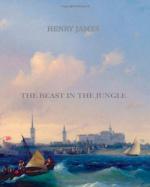|
This section contains 6,048 words (approx. 16 pages at 400 words per page) |

|
In the following essay, Gargano provides a detailed analysis of the function of imagery in "The Beast in the Jungle," relating it to the story's themes and characterization.
In "The Beast in the Jungle," Henry James attempts to make a formidable dramatic action out of what he calls in one of his most interesting prefaces "a great negative adventure." The point of the story is the pointlessness of John Marcher's subordination of reality to his belief that a unique and possibly terrible destiny awaits him. Marcher's special fate (to be "the man, to whom nothing on earth was to have happened") is made vivid by his involvement or non-involvement with May Bartram, a devoted companion who represents the possibility of a more fruitful life. In essence, "The Beast in the Jungle" traces Marcher's tortuous route to total negation through a series of episodes in which he fails...
|
This section contains 6,048 words (approx. 16 pages at 400 words per page) |

|




